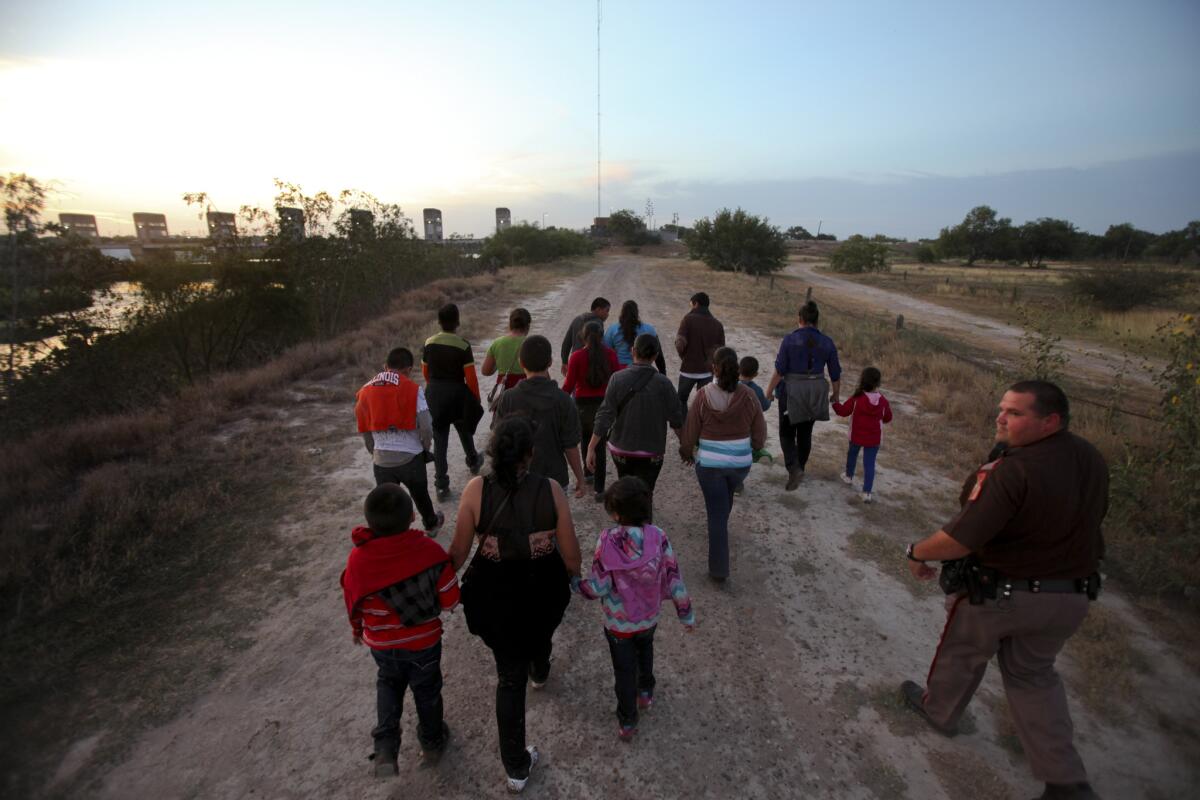Immigrant border surge dips; crossings forecast to rise in summer

- Share via
Reporting from Houston — The number of Central American children and families illegally crossing the southern border, particularly in Texas’ Rio Grande Valley, is likely to be smaller this year than last, but large enough to overwhelm shelters and courts, new Border Patrol statistics and projections show.
There were 12,509 unaccompanied youths, most of them from Central America, caught at the southern border during the first five months of the federal fiscal year that began in October, down 42% compared with the same time period last year, according to the latest Border Patrol figures. A total of 11,133 family members were caught at the border during this time period, 21% fewer than the same period a year before.
That means the Border Patrol is on pace to catch about 39,000 unaccompanied children and about 53,000 members of families on the southern border this fiscal year, according to Adam Isacson, a senior associate at the nonprofit Washington Office on Latin America, or WOLA. Isacson based his projection on past immigration patterns, which tend to increase March through July.
If the projections hold, it would represent a 43% decrease in unaccompanied children and an 23% decrease in family members this fiscal year compared to last.
But even with the projected decline, the number of family members crossing the border illegally would be more than triple the number in 2013, when 14,855 crossed.
More than half of the children and families still appear to be crossing through the Rio Grande Valley, which saw 17% fewer family members compared with this time last year and nearly half as many children, the Border Patrol reported.
Border Patrol officers are on pace to apprehend far fewer Honduran children and families this fiscal year compared to last: 3,758 unaccompanied children — 79% fewer and the lowest total since 2012 — and 12,680 family members, a 63% drop, according to WOLA predictions.
They are also expected to detain fewer Salvadoran children and families this year: 7,030 children, or 57% fewer than last year; 13,161 family members, or 11% fewer than last year, according to WOLA.
Bryan Johnson, a New York-based lawyer who works with immigrant youths and families, said the decrease in Honduran immigrants caught crossing so far this fiscal year was probably a result of the Obama administration speeding deportations and encouraging Central American countries to crack down on illegal immigration.
This summer in south Texas, “I don’t think it’s going to be as high because of the administration’s efforts to stop it, but it’s still going to be substantial,” Johnson said.
Compared with last year, however, the Border Patrol has caught more Guatemalan and Mexican families.
It is expected to apprehend 18,105 Guatemalan family members this year, up 51%; and 8,962 Mexican family members, up 59%; according to WOLA.
Isacson said it’s not clear why the number of Guatemalan migrants would increase and others decrease. “It may simply be economic — drought, poor harvests. That could be enough” to account for the increase, he said.
The U.S. Customs San Diego sector has seen 397 unaccompanied minors caught crossing so far this year, a 33% increase compared with this time last year, said acting Assistant Chief Patrol Agent Richard Smith. Though the percentage increase was “significant,” he considered it “not an alarming trend at this time.”
Last summer, immigrant mothers and children who arrived in the Rio Grande Valley were initially detained in overcrowded Border Patrol holding areas, forced to sleep side by side on concrete floors without immediate access to showers and medical care as officials scrambled to add services and open massive emergency shelters, some at military bases.
The Border Patrol has been recruiting more female agents to deal with the influx, and the Department of Homeland Security has opened more detention centers, including two in Texas that house hundreds and are expanding to eventually house thousands. Immigration courts made the cases a priority.
There are 7,300 beds available for children caught crossing the border alone, compared with about 3,000 beds a year ago, and the average stay is about a month, according to Kenneth Wolfe, a spokesman for the Department of Health and Human Services, which runs the shelters.
“The federal government has engaged in an aggressive, coordinated response to provide humanitarian care,” Wolfe said, adding that they have also been “heightening deterrence, enhancing enforcement, strengthening foreign cooperation and increasing border security.”
“As a result of these efforts, the number of unaccompanied children attempting to cross the Southwest border has declined precipitously, and the federal government continues to focus its resources to prevent a similar situation from developing in the future,” he said.
molly.hennessy-fiske @latimes.com
More to Read
Sign up for Essential California
The most important California stories and recommendations in your inbox every morning.
You may occasionally receive promotional content from the Los Angeles Times.











